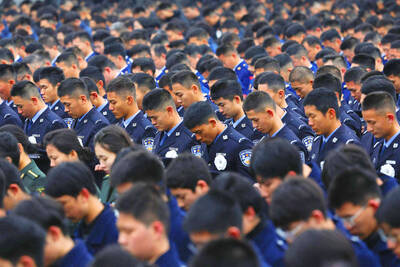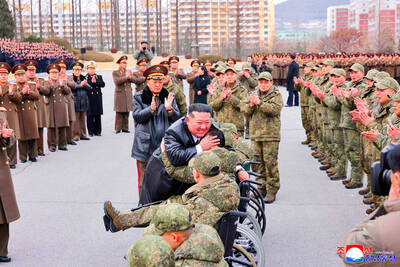Parts of China’s troubled northwest region of Xinjiang have begun offering cash to interethnic couples as part of a drive to assimilate the culturally distinct Uighur minority.
Qiemo County, part of the 460,000km2 Bayinguoleng autonomous Mongolian prefecture, announced the policy late last month, calling it a “big celebratory gift package” for couples in which one member is an ethnic minority and the other is Han Chinese.
The package includes annual cash payments of 10,000 yuan (US$1,630) for interethnic couples during the first five years of their marriage, as well as housing, healthcare and education subsidies, according to a statement on the Qiemo County Government Web site.
“Ethnic groups are different only in that we have different languages and different customs, but we have the same blue sky above our heads, the same fertile ground beneath our feet, and the same love in our hearts,” Qiongkule Township committee deputy secretary Yasen Nasier told journalists during the announcement on Aug. 25.
“I believe that intermarriage between ethnic groups is a foundation of Chinese culture, and will strengthen the concrete expression of exchange, association and mingling of all ethnic groups,” Nasier said.
A county official confirmed the policy when reached by telephone.
“This is meant to promote ethnic unity — that’s the main thing,” the official said.
Xinjiang is China’s largest province, a vast sweep of mountains, forests and deserts bordering seven central and south Asian countries, including Afghanistan and India. Uighurs, a Turkic-speaking, predominantly Muslim ethnic group, make up the region’s plurality. When Chinese Communist Party (CCP) troops took control of Xinjiang in 1949, Han Chinese only made up 6 percent of its total population. Today they make up nearly half.
While ethnic intermarriage is fairly common across China, it is rare between Uighurs and Han Chinese, underscoring the groups’ deep-rooted cultural, religious and linguistic differences. The region’s cities are often clearly divided along ethnic lines, with Han residents frequenting separate shops and restaurants from their Uighur counterparts.
The region has seen a sharp rise in violent incidents in recent years, including attacks on police stations and government offices, and increasingly, terror attacks in major urban centers. In late May, an attack at a crowded market in the region’s capital city, Urumqi, killed 31 people and injured dozens. A month later, nearly 100 people were killed and 215 arrested when knife-wielding mobs rampaged through Shache, a county in Xinjiang’s arid southwest, marking the region’s worst clash in five years.
State media reports consistently blame the violence on Muslim fundamentalists, terrorists and “separatists,” and point to economic growth and preferential ethnic policies as evidence of good regional governance.
Yet the region’s 8 million Uighurs complain that the economic growth has mainly benefited the Han Chinese, and that local authorities place severe restrictions on their religious and cultural freedom, including bans on veils, beards and worship at non-state-sanctioned mosques.
Qiemo’s interethnic marriage policy “seems of a piece with general assumptions about Chinese policy in the region, in the sense that the party appears to believe that material incentives can overcome or mediate most political, economic and social problems,” said Michael Clarke, an expert on Xinjiang at Griffith University in Australia.
According to the US-based broadcaster Radio Free Asia, Qiemo officials have counted 57 mixed-race couples within their jurisdiction, in a county with a total population of about 60,000. The policy is experimental and subject to change.
China also recently began promoting interethnic marriages in Tibet, its other politically recalcitrant ethnic frontier, according to a slew of state media reports published this summer. The CCP’s highest official in the Tibetan region, Chen Quanguo (陳全國), had himself photographed with a large group of Tibetan-Han mixed-marriage families in the middle of June. Interethnic marriages in the region grew from about 700 in 2008 to more than 4,700 last year, according to a report by the CCP’s research office in Tibet.
“This seems to be part of a much larger effort by the [Chinese] government to essentially socially engineer support for a decidedly Beijing-centric perception of what a society should look like — or at least to minimize objections to the central government’s policies,” said Sophie Richardson, China director at Human Rights Watch. “It seems to presume that Han will be supportive of government policies — a reality which is manifestly not true — and somehow, that the construct of marriage will promote that political loyalty.”
“It certainly strikes me as one of the perverse efforts by a government that’s known to engineer its way out of human rights abuses rather than removing the abusive policies that lead to protests in the first place,” she said.

The Burmese junta has said that detained former leader Aung San Suu Kyi is “in good health,” a day after her son said he has received little information about the 80-year-old’s condition and fears she could die without him knowing. In an interview in Tokyo earlier this week, Kim Aris said he had not heard from his mother in years and believes she is being held incommunicado in the capital, Naypyidaw. Aung San Suu Kyi, a Nobel Peace Prize laureate, was detained after a 2021 military coup that ousted her elected civilian government and sparked a civil war. She is serving a

China yesterday held a low-key memorial ceremony for the 1937 Nanjing Massacre, with Chinese President Xi Jinping (習近平) not attending, despite a diplomatic crisis between Beijing and Tokyo over Taiwan. Beijing has raged at Tokyo since Japanese Prime Minister Sanae Takaichi last month said that a hypothetical Chinese attack on Taiwan could trigger a military response from Japan. China and Japan have long sparred over their painful history. China consistently reminds its people of the 1937 Nanjing Massacre, in which it says Japanese troops killed 300,000 people in what was then its capital. A post-World War II Allied tribunal put the death toll

‘NO AMNESTY’: Tens of thousands of people joined the rally against a bill that would slash the former president’s prison term; President Lula has said he would veto the bill Tens of thousands of Brazilians on Sunday demonstrated against a bill that advanced in Congress this week that would reduce the time former president Jair Bolsonaro spends behind bars following his sentence of more than 27 years for attempting a coup. Protests took place in the capital, Brasilia, and in other major cities across the nation, including Sao Paulo, Florianopolis, Salvador and Recife. On Copacabana’s boardwalk in Rio de Janeiro, crowds composed of left-wing voters chanted “No amnesty” and “Out with Hugo Motta,” a reference to the speaker of the lower house, which approved the bill on Wednesday last week. It is

FALLEN: The nine soldiers who were killed while carrying out combat and engineering tasks in Russia were given the title of Hero of the Democratic People’s Republic of Korea North Korean leader Kim Jong-un attended a welcoming ceremony for an army engineering unit that had returned home after carrying out duties in Russia, North Korean state media KCNA reported on Saturday. In a speech carried by KCNA, Kim praised officers and soldiers of the 528th Regiment of Engineers of the Korean People’s Army (KPA) for “heroic” conduct and “mass heroism” in fulfilling orders issued by the ruling Workers’ Party of Korea during a 120-day overseas deployment. Video footage released by North Korea showed uniformed soldiers disembarking from an aircraft, Kim hugging a soldier seated in a wheelchair, and soldiers and officials